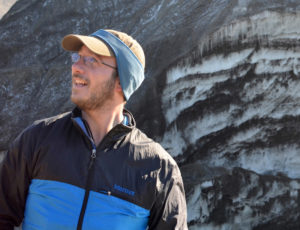
Joe Levy
What is a permafrost geologist?
I like to say that I’m a geologist whose favorite rock is ice. I’m interested in how water–in its solid and liquid forms-interacts with soil and rock, and how that affects landscapes. I’m working with some of the fastest changing landscapes on Earth: those powered by melting or growing ice.
One of those landscapes is the McMurdo Dry Valleys area of Antarctica, where you conduct much of your research. Although your blog has lots of photos and video from that place, and there is a web cam of the McMurdo Station, most people have no idea what that landscape really looks and feels like. Can you describe it for us?
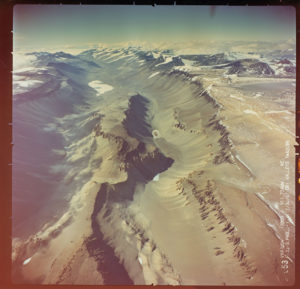
Wright Valley, one of the McMurdo Dry Valleys ©US Navy
The McMurdo Dry Valleys are the tiny, less-than-one-percent of the Antarctic continent that is not completely covered by ice sheets. It is a stark, mountainous landscape with bare rock exposure, soils that are mostly sand and windblown dust, a patchwork of little glaciers that creep down from the mountainsides, ephemeral melt water streams that flow for just a month or two out of the year, and lakes that are permanently covered by thick ice. It’s a real alien landscape.It is a place where you only get three to 50 millimeters of snow per year, and almost all of it sublimates into the air and never melts. It is a stark, but beautiful landscape that is somewhat similar to the hot, dry landscapes in the American southwest, only it is shaped by ice.
Despite how barren it is and how bleak it appears, it is home to a small, but hardy and interesting ecosystem, which is dominated by microbes. There are soil-dwelling, stream-dwelling, and lake-dwelling microbes, as well as crypto-endolith microbes that live inside the quartz in the bedrock. It is an ecosystem that is limited by the availability of water. It springs to life in the summer, when there is a little bit of melt water, and it has developed interesting strategies for going dormant for the remaining ten months of the year. It has been described as a Mars-like landscape and potentially a Mars-like ecosystem.
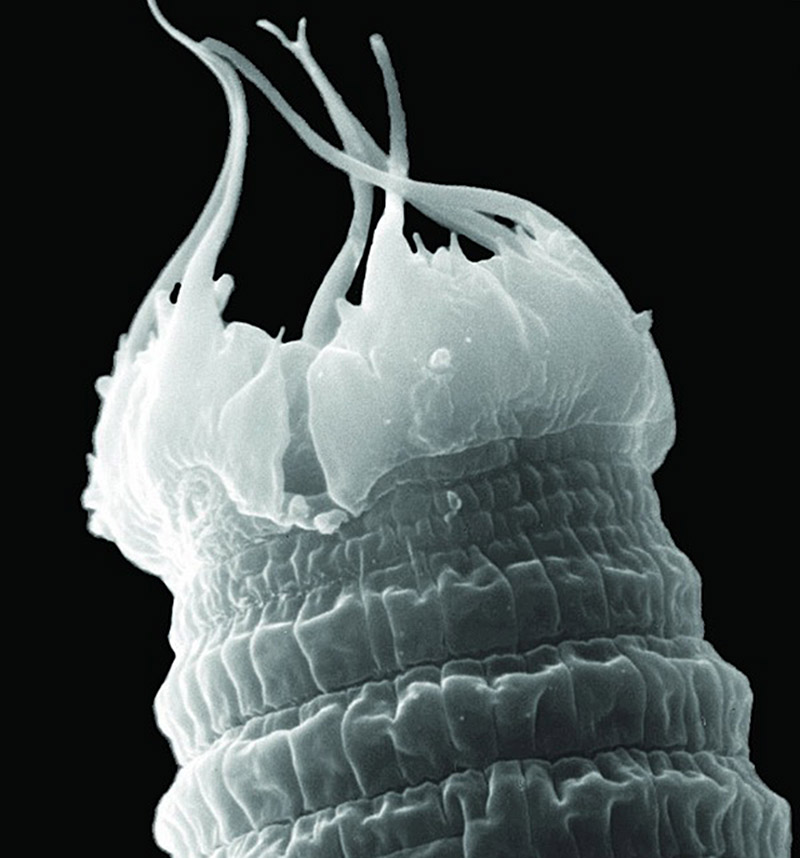
Scottnema ©Manuel Mundo Campo
It seems like most research related to thawing permafrost is conducted in the Northern Hemisphere. Why is it important to study permafrost in the Southern Hemisphere?
About one-fifth of Earth’s land surface is permafrost. There is absolutely more permafrost in the Northern Hemisphere, and that permafrost can be tens of thousands of years old, dating back to the last Ice Age. In Antarctica, there is permafrost that has been frozen for eight million years or more. While there is much less of it in terms of area, it is much older, and much more exotic. It records more Earth history than permafrost in the Arctic. Arctic permafrost is of concern because it is carbon rich and a tremendous methane source. Permafrost in Antarctica is important because it is a recorder of ancient climate conditions.
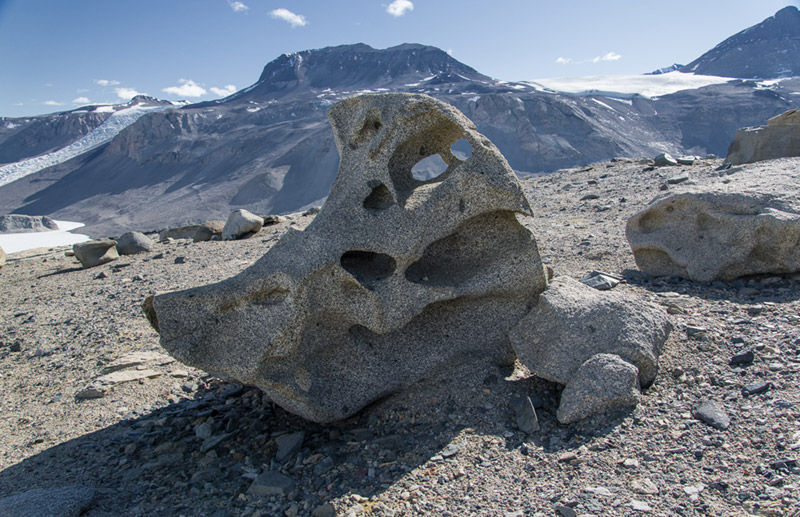
Taylor Valley one of the McMurdo Dry Valleys ©Helen Glazer
Usually, when people think about trying to reconstruct past climate, they’re thinking about records stored in ice cores, lake cores, or in the ocean sediments-places where you can pile up geological material, read its chemistry or composition, and figure out how that region has changed over time. Using ice is tricky, though, because ice moves, flows, and doesn’t always trap what you want it to trap. And oceans can be gouged up. The permafrost in Antarctica is an important complement to ice cores and ocean records. These surfaces in the Dry Valleys in Antarctica that are covered in permafrost are long-term repositories. The Antarctic environment is kind of like a messy desk. Things have piled up and you can look back in time and ask, “What was I working on last week? A year ago?” You can read a record of past glaciations. You can ask, “Where was there an ice sheet? Where was it scraping past this valley? How high was the ice? How fast was it moving? What kind of boulders was it carrying? “ All of that information is locked in the permafrost.
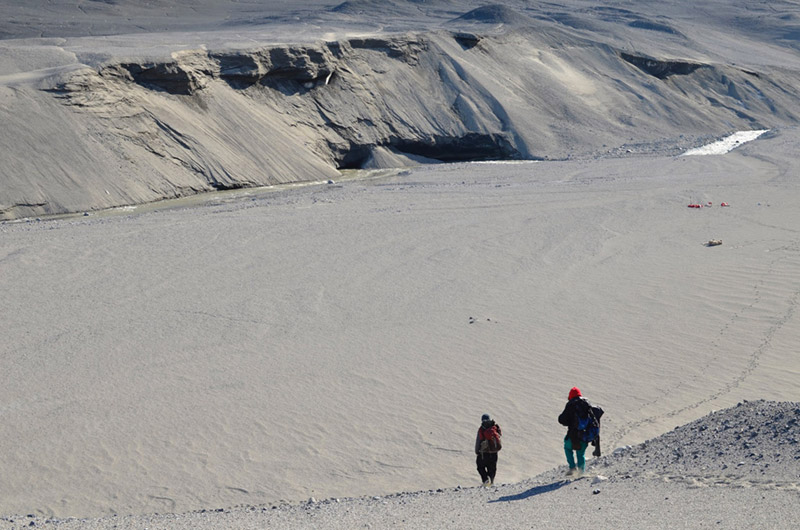
Leading students to Garwood River Breadplain ©Logan Schmidt
You can also learn about how quickly the ice melts. Ice sheets grow and shrink over geological time. One of the ways ice shrinks in Antarctica is by melting. The water flows off and forms lakes. In the past, huge lakes and fjords covered the dry valleys of Antarctica, and all of the sediments that piled in those lakes and formed deltaic and shoreline deposits have turned into permafrost; they’ve been frozen in place. Sediments that would otherwise just blow away have been locked there, and we can read their history.
What does it feel like to be able to unlock this material?
It is a tremendous amount of fun to explore these deposits. I have another life as a planetary geologist exploring the geology of Mars. When I work in Antarctica, I have that same feeling of exploration, wonder, and mystery. These are really alien deposits; they are different from anything you could be trained for in temperate latitudes. So anytime you figure something out, there is a tremendous sense of accomplishment and excitement. Often these are landforms that have not been studied in great detail, so there is a real opportunity to learn new things about how Earth works, and how landscapes develop.
What have you learned so far about the rate at which permafrost is thawing in Antarctica?
For the longest time, there was a sense that Antarctica was separated from Earth’s greater climate system, in the sense that it was being protected by strong Circum-Antarctic winds, and that there was not a lot of regional warming or melting. Antarctic permafrost is classically described as being cold, dry, and very much frozen. That picture is changing. Over the last 10-15 years, the regional cooling we have seen in the Dry Valleys has given way to stable and potentially warming conditions. The cloud cover distribution has changed, so the Dry Valleys have been getting brighter. That’s nice if you’re working there, but it is very worrisome when it comes to permafrost. This is an environment that gets much of its heat by absorbing sunlight during the short Antarctic summer. We have seen acceleration in melt and, in many places, a deepening of the top, active layer of permafrost. The permafrost is also becoming quite a bit wetter in places. When the ice in permafrost melts, that makes the soil wet, and that allows a lot more heat to enter the soil from the warm surface, so thaw begins to beget thaw. This is a normal process in the Arctic, but was quite unexpected in Antarctica. There is a real concern that as these soils begin to transition from cold and dry to seasonally damp, we’re going to get deeper and deeper thaw depths and potentially all of these land-based, climate-related deposits will turn into mud, mix together, and lose all of their usefulness for decoding past climate.
Can you talk a bit more about the impact of thawing permafrost on our ability to study and understand climate history?
The big question that hangs over the whole cryosphere is: how quickly do ice sheets collapse, sea levels rise, and how quickly does atmosphere circulation and rainfall change? That’s the de-glaciation problem. We’re less worried about how quickly ice ages begin, because that is a far-off problem for us.
Records stored in Antarctic permafrost are telling us how quickly ice sheets shrink. As the giant Antarctic ice sheets scrape past the Dry Valleys, they erode away notches in the hillside. These are like the notches in the doorframe of the house when I was growing up. Every year, my brothers and I would get measured, and our heights would get marked on that doorframe. There were different lines for different kids, and you could read the record of everyone’s growth. This is like that but in reverse. Different glaciations scrape past, and you can see how high the ice was at different periods in time. Those are permafrost deposits, and they are only preserved there because the landscape is so cold and erosion is so slow that these glacial trim lines are preserved. If those slopes begin to thaw and melt, creep downhill and make rounded hillsides, we’re going to lose those scrapes, along with that repository of several glaciations worth of ice growth and shrink records.
What do we know about the impacts of thawing permafrost in Antarctica on the regional hydrology and ecology, or on downstream systems like the Ross Sea or Southern Ocean?
The landscape in the Dry Valleys is shaped by melt water at the small scale. All of the stream channels that flow down through the Dry Valleys are not just eroding sediment, but bringing heat into the permafrost and causing more erosion. They are self-reinforcing systems, part of a positive melt feedback.
The ecosystem in the Antarctic has been described as an ecosystem that is “waiting for water.” Any process that brings more water into surfaces that have been dry for tens of thousands of years is going to change the community structure. If you are a large organism that really likes dry habitats, you can just migrate to a new, dry habitat. But if you are a microbe that lives in the soils, or the Dry Valley’s top predator, a nematode, even a one-meter move from flooded to dry soil might be insurmountable.
We would expect that we will change the suitability of habitats by adding more permafrost meltwater to them. Right now, the nematodes we see are highly segregated. There are Scottnema nematodes, which like dry, salty soils, and Plectus nematodes, which like wet, not salty soil. When you start mobilizing water, you can wash salts from one bit of soil to the next. You can flush out salty soils and make them not salty. Or, you can bring a tremendous amount of saltwater into suitable nematode habitats and completely disrupt the community. The ecological impacts of this thaw are just beginning to be researched and understood. That is because the extent of the thaw and the rapidity with which water is starting to move on what used to be dry slopes is only just beginning to be appreciated.
How can people stay up to date on that research?
A lot of the ecological work is being done by or in coordination with the McMurdo Dry Valley’s Long Term Ecological Research (LTER) group, which has been observing the soil ecosystem for more than 20 years. It has been exciting to be an instigator with the LTER asking questions about permafrost thaw and melt water runoff, because there has been a lot of mystery around what is structuring these soils. What cracked open in the last five or six years is that there is a lot of melt water moving through underground streams called “water tracks,” and they shape where microbes and things that eat microbes live.
Tell me more about “water tracks.” What are they, and why are they important to study?
Water tracks are underground streams: melt water that flows within the soil. Water tracks flow below the surface of the ground, but above the frozen part of the permafrost. Sometimes that water wicks up and darkens the surface of the soil. When you’re walking along in the Dry Valleys, you sometimes encounter these lightning bolt streaks of dark soil moving down the slopes.
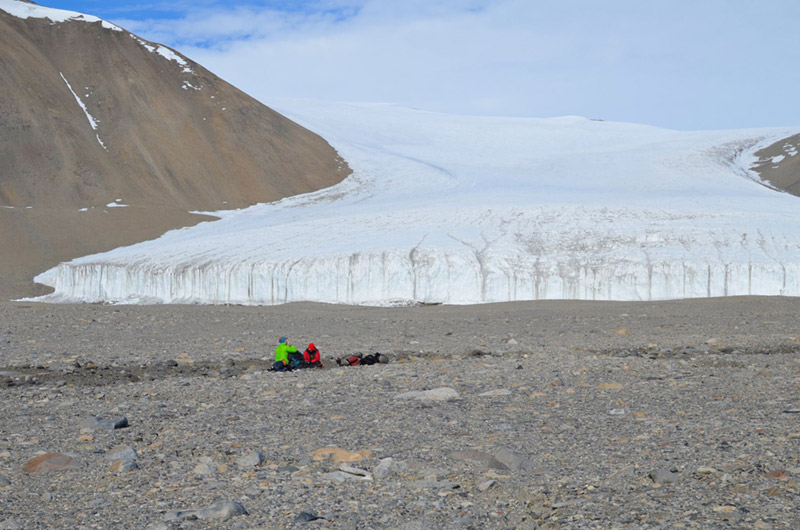
Working on a water track in front of Howard Glacier ©Logan Schmidt
In the Arctic, people had studied water tracks for years, and understood that they were the beginnings of streams. They were how water in a frozen watershed started its route towards a lake or ocean. Bringing that Arctic model for how water is moving and routing salts and heat to the Antarctic is something I’m proud to have helped push along. It explains so much that used to be mysterious about how this landscape is structured and why the soil is light in some places and dark in others. Water tracks also help explain why nematodes that previously seemed picky and idiosyncratic in their locations were being shaped by a physical and geological process.
Speaking of those nematodes… someone living in an urban area in the temperate zone, like my city of Baltimore, MD, might ask, “What does a nematode in Antarctica have to do with me?” Can we answer that question yet?
We can certainly begin to answer it. Nematodes are thought to be marker organisms. They are canaries in the coal mine for how much Antarctica is going to change. That nematode can tell us about thawing, melting, and environmental change. This is important because that thawing and melting can eventually get transmitted across the whole ice sheet and results in widespread ice sheet melt and sea level change.
Antarctica is really one of the lynchpins in global sea level, and also in global circulation of climate and weather. What happens to Antarctica’s ice affects not just the water level in Baltimore Harbor, but also the storminess, the amount of cloud cover, humidity, and rain. The poles are Earth’s radiators, the places where Earth is shedding all of the heat it absorbs from the sun. When the radiator changes in your car, the engine behaves differently. Understanding changes to the Antarctic environment-particularly changes in the amount and distribution of ice, and how much it is melting-are climate clues we can get from permafrost deposits and the modern ecosystems that live there.
Many people know nothing about permafrost, and among those who do, the notion of thawing permafrost can be something distant and perhaps abstract. You have been conducting research in the McMurdo Dry Valleys since 2004. Have there been visible changes in the landscape there as a result of permafrost thaw, and if so, can you describe them?
Most of the time permafrost is well-behaved and largely invisible. This was particularly true in nice, dry, cold, stable Antarctic permafrost. The big changes we started noticing in 2007 were largely discovered by helicopter pilots who were shuttling scientists from valley to valley. These pilots started reporting seeing huge slumps forming. They saw buried exposures of ice that were melting and sloughing away, dropping their mud into streams, and forming giant ice cliffs. The most iconic was in Garwood Valley. These ice cliffs are appearing all along the edge of the Ross Sea in extremely ice-rich permafrost. This permafrost is actually a remnant of the last Ice Age’s ice sheets that have been covered by dirt. If you walked on its surface, you’d think, “I’m on permafrost,” but if you dug down, you’d see that you are on permafrost that is on top of old, dead, glacier ice. Once these ice cliffs expose the ice to the air and sun, it begins to warm and melt. The feedback we’re seeing is that as this old, volcanic soil that sits on top of the ice falls onto the faces of the ice it gets darker, and thus absorbs more sunlight. This then causes runaway melt.
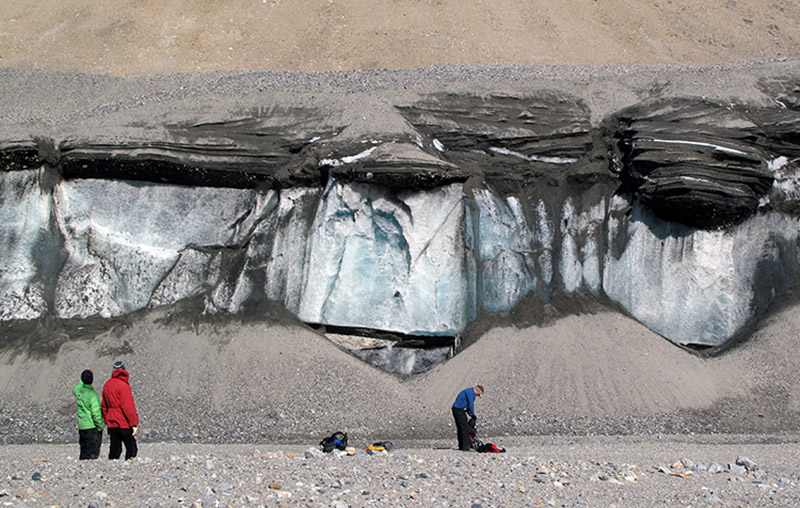
Garwood Valley ice cliff ©Logan Schmidt
There have also been changes that have affected infrastructure. When that happens, all of a sudden there is a lot more interest. In the last couple of years, all around Ross Island (home to the U.S.’s McMurdo Station and New Zealand’s Stott Base), there have been ice cliffs forming in the Ross Sea drift permafrost deposit on top of which these stations are built. You see signs warning people not to go near the cliffs. There is significant concern that this is going to start impacting the coastal infrastructure that supports research in Antarctica.
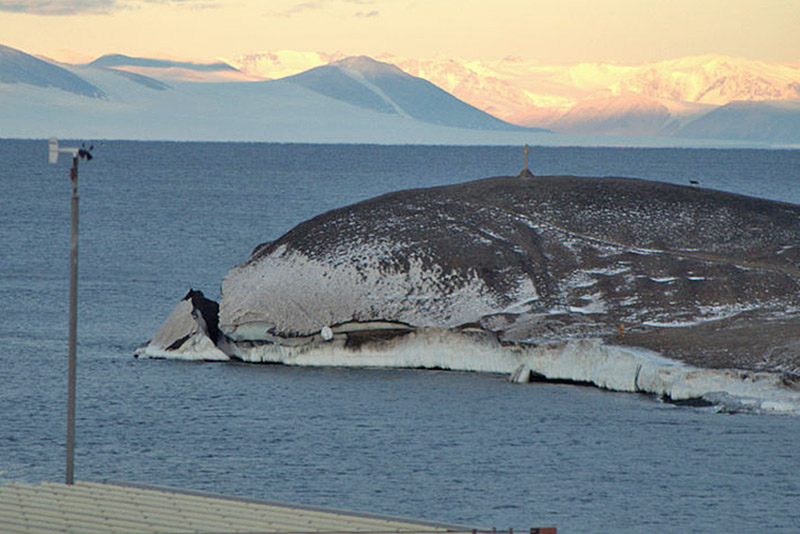
Thermokarst erosion occurring at Hut Point, close to McMurdo Station ©Elaine Hood
You mentioned U.S. and New Zealand research stations? What other nations are leading the way in terms of permafrost research in Antarctica?
Permafrost research is very international, both in the Antarctic and Arctic. In addition to the U.S. and New Zealand, there is an Italian station at Terra Nova Bay. Korea and China are building new stations that are on the coast and therefore either in permafrost affected soils or perched on bedrock. Whether it is Argentine or Chilean bases on the Antarctic Peninsula, or U.S., Italian, or New Zealand bases on the Ross Sea, anywhere there is a tiny spit of land for a stable base, some nation has built a station and they are contributing to big data sets looking at how deeply the surface is thawing in the summer and how that is changing over time.
Is there some kind of central repository that holds all of that data?
The Circumpolar Active Layer Monitoring (CALM) program has a clearinghouse web site. The Scientific Committee for Antarctic Research (SCAR) has a permafrost working group that maintains a web site that distributes some of that data. The National Science Foundation now has its own, searchable repository that includes meteorological station data and other data that didn’t fit neatly into other public data repositories. The U.S. Antarctic Program Data Center is also a new source. The McMurdow Dry Valleys LTER has live streams of data and archived data from all of the soil monitoring and thaw monitoring plots.
If it’s a hot day in summer and you really want to chill with some Antarctic permafrost, you can do so on your computer!
Do permafrost researchers in Antarctica collaborate with permafrost researchers in the Arctic?
There are a handful of “bipolar” permafrost scientists. Increasingly, there are connections and collaborations happening, whether it is between the Toolik [Arctic] and McMurdo Dry Valleys LTERs, or just disciplinarily. The biggest obstacle to this in the past was the sense that Antarctica was different, that its permafrost was not part of the northern hemisphere permafrost system and there was not a lot that the two communities of scientists had to say to each other. But now, as we begin to recognize water tracks melting and coastal retreat in Antarctica, there is going to be a lot more dialogue and a lot more sharing of techniques and approaches.
You have studied the icy geology of Mars. Have you studied any other planets?
I study Earth, Mars, and a tiny bit of Titan, which is Saturn’s moon. Titan is a very cold place. A cold day in Antarctica is like an average day on Mars. An average day on Titan is 94 Kelvin. However, Titan still has fluvial landforms. It’s just so cold that the bedrock is made out of water ice, and the liquid is made out of hydrocarbons. What interests me is trying to understand the mechanisms that shape landscapes on any planet. These mechanisms are influenced by the material, but the basic laws of erosion, sediment transport, and growth of deposits are the same. Once we figure out these basic mechanisms, we can use different planets as analogs to make sure these models for climate and surface processes work.
Many Leaf Litter readers are fluvial geomorphologists. Has your research on Mars or Titan given you any insight into to the implications of permafrost thaw here on Earth?
What makes Martian fluvial geomorphology really interesting and analogous to Antarctic streams is how “pulsy” the streams are. There is very little evidence of continuous flow. There are watersheds that are extremely limited in how much runoff can occur, because they are limited by both melt-rate and/or snow volume. Understanding how optimum events (like having the right amount of snow in the right place at the right time to be exposed to melting and make a landform) is critical to understanding the evolution of streams in Antarctica and in other permafrost environments.
Why are so few people talking about thawing permafrost, and what can we do to change that?
If you asked anybody on the street, “Should we protect highly diverse rainforests and coral reefs?” people would jump up and down to find ways to help those environments. You don’t hear that with permafrost. It’s not for lack of charismatic critters. Permafrost shorelines are home to walruses, penguins, and polar bears. I think the chain of reasoning that something going on in the ground in a faraway place can have an impact on climate isn’t there.
Hopefully, as research is promoted and shared, that will change. I think that every researcher working in the polar region has an obligation to share their experience with people living in temperate latitudes, because the impacts of thawing permafrost are going to be felt everywhere.
Your research is highly technical, yet your blog is conversational and very accessible. Why is it important for your blog to have that shift in voice?
There are two reasons. All research, no matter how technical and complicated, is founded in the basic scientific principles of making observations, interpreting them, using them to test a hypothesis, and, if you’re lucky, disproving that wrong hypothesis so you can move on to find a new, better hypothesis and gradually get closer to the truth. It is easy to lose that in scientific papers. I think paring away the jargon and the assumptions I would otherwise bring to my work makes me a better scientist.
The other aspect is the real need to communicate. I am passionate about polar change. I am early in my career and I am seeing it. That is both alarming and exciting. Making people more aware of what is going on at Earth’s poles is an important part of my mission. I will do anything I can to raise awareness and remind fellow countrymen that this is something that the U.S. has to show leadership on. We need to vote for representatives who will provide funding to support this work. This is not just because it is my professional livelihood; it is fundamentally important science. It’s something worth shouting about.
What do you find most rewarding and most challenging about your job?
The most rewarding part is seeing old landscapes in new ways. This often happens when I take students out to Antarctica. Every time I bring an undergraduate to the field, it is a new experience for them, so they see something new that I may not have seen before.
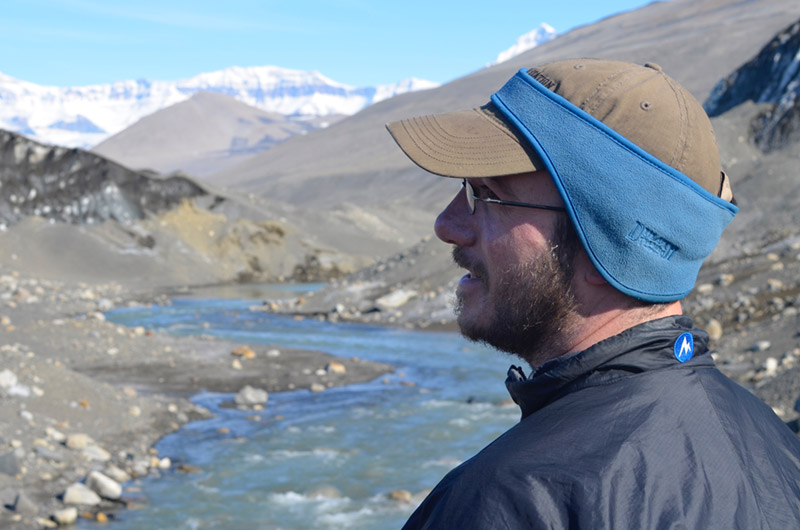
The biggest challenge is two-fold. Getting to Antarctica and conducting research there takes time. Being away for the austral summer, which is northern hemisphere winter, means a lot of time apart from family during the holidays. It means missing my son’s January birthday. That is personally frustrating, but it is worth it to me because I think the research is important.
Professionally, the great challenge is combatting the lack of awareness and complacency about melting permafrost. These landscapes were sculpted by ice ages, and we’re lucky enough to have had them preserved to the modern day in Antarctica and parts of the Arctic. But once they’re gone, they’re gone.
What can Leaf Litter readers do, whether through their work or in the way they communicate with clients and colleagues, to slow down the thaw or help advance the study of permafrost?
Immediately actionable steps can be taken with the permafrost that is not too far from home. There is mountain permafrost in the U.S. in watersheds that are in many people’s backyards. Anyone who lives in Denver, Salt Lake City, or any big, western city is touched by our domestic, alpine permafrost. In the Arctic, whether in Alaska, Canada, Russia, or Scandinavia, people are living with these surfaces, so there are opportunities to study them and learn how to slow down heat transfer into soil. There are management strategies for inhabited or near-inhabited permafrost that can help. Whether it is changing forest or grassland management, or figuring out something to do with the surface energy balance, there are design opportunities there. There is so much infrastructure, there is going to be a need for more permafrost management strategies. It is a good time to think about how to protect what is there.
Do you have any advice for students who are interested in potentially pursuing a career in permafrost research?
The gloom and doom advice is to get out and see these landscapes before they are gone. Push your universities to have field trips to arctic or alpine areas. Get out and experience them. In many places, we are beginning to see an inflection point. The world in which young people are going to be working professionally is going to be different from the one we are monitoring now.
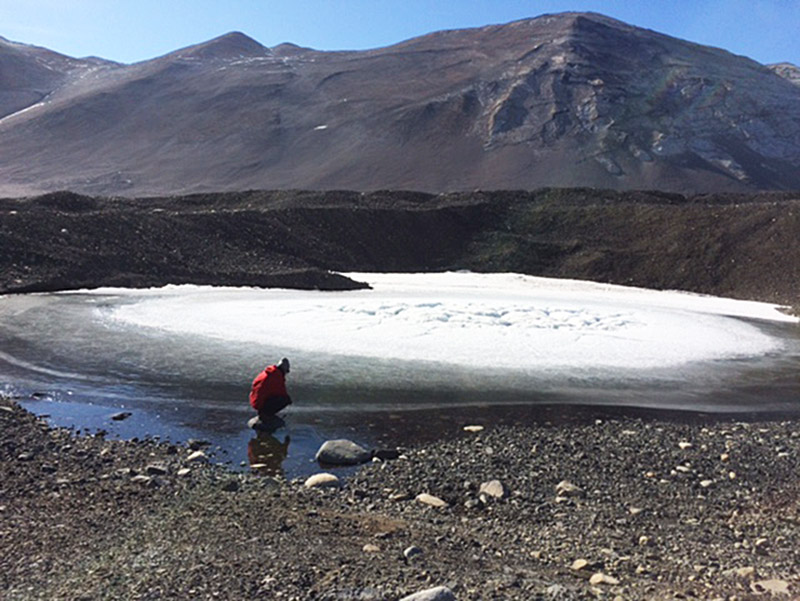
Undergrad sampling thermokarst pond, Garwood Valley
There is a real need for a new generation of scientists who are experienced with remote sensing data and integrating it across a whole landscape. We need scientists who are informed about what is going on in the mud, but who can apply that knowledge over huge areas. With landforms and climate regions as inaccessible as permafrost regions, you need many different tools, and you need to know that you are making the right models.
When is your next trip to Antarctica, and what will you be working on?
I’m heading to the Dry Valleys this January with the New Zealand Antarctic program. I’m working with a group of Kiwi scientists who are interested in the distribution and health of microbial mats-Antarctic forests of microbial photosynthetic organisms that live at the surface. We’re going to map them with drones and hyperspectral imaging cameras to get a baseline measurement for these sentinel organisms. Then, we can see how that changes with time as soils get wetter or drier, saltier or less salty.
We think that the Dry Valleys are on the cusp of a major change from dry, isolated streams to wet, well-thawed permafrost. We expect that these mats, which are well-adapted to the soils that they’re on, are going to change in response to melting. The hope is to both understand how their biological function changes in response to changing climate and soil conditions, but also to use them as a marker for changing soil chemistry by watching how they move. We’re trying to get the mats to work for us.

